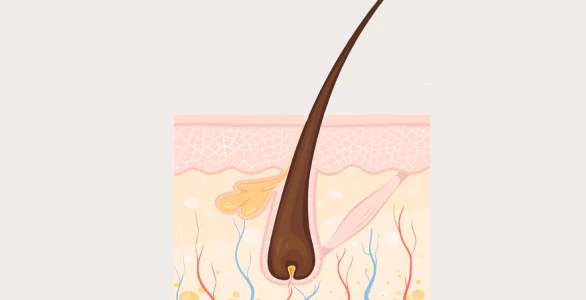Your Cart is Empty
20% off with "BF25" at checkout
20% off with "BF25" at checkout
20% off with "BF25" at checkout
March 21, 2025 3 min read
Hair loss is a concern for many women, but understanding what's typical can help manage unnecessary worry. It's completely natural for women to shed hair daily, as hair growth and shedding follow a precise cycle. However, when you start seeing noticeable clumps of hair or excessive thinning, it can prompt anxiety. Understanding what's normal for female hair loss can help you manage expectations and determine when professional intervention is needed.
On average, most women lose between 50 to 100 hairs per day. This figure may sound high at first, but considering you have roughly 80,000 to 120,000 hairs on your scalp, this quantity usually goes unnoticed. Daily shedding is part of the hair follicle's lifecycle, making way for new hair growth every day.
If you're concerned about noticing loose hairs in your comb, shower drain, or pillow, rest assured this is usually within the normal range. Factors such as hair length, styling habits and hair washing frequency can impact how noticeable shed hairs become. Remember, normal hair shedding varies slightly from individual to individual and can fluctuate with specific life stages or seasons.
Although daily shedding is generally common, you may notice increased changes that point towards abnormal hair loss. Signs that might indicate your hair loss exceeds the typical range include:
If these symptoms become persistent or severe, it's prudent to seek advice from a dermatologist or a hair care professional to rule out underlying health issues.
A range of factors can impact how much hair you lose each day. Hormonal changes are a common reason for changes in hair density. Events such as pregnancy, postpartum phases, menopause and ageing can cause fluctuations that affect hair shedding patterns. Medical conditions, stress, nutritional deficiency, weight loss, thyroid disorders or autoimmune conditions like alopecia can also lead to increased shedding.
Additionally, certain hairstyles that continually tug at the hair roots or aggressive hair treatments may contribute to hair loss over time. Ensuring your styling habits align with good hair health practices can greatly affect your hair's overall health.
Although you can't count each hair that falls, simple techniques can help assess if you're maintaining a normal shedding rate. Conduct a gentle pull test by softly gripping 50 to 60 strands and sliding your fingers down; losing less than six hairs during this test usually indicates normal hair loss. Keeping track visually by routine examination of your brush, pillow, and shower can provide insight into daily hair fall.
Consistently monitoring changes helps you understand what's typical for your specific situation. It can help you quickly recognise unusual increases or patterns, guiding you on when professional assistance may be beneficial.
If you're worried about potentially abnormal hair loss, there are practical and proven ways to address it effectively. Following a healthy diet that's rich in nutrients—particularly vitamins, iron and protein—is essential for overall hair health. Reducing excessive hairstyling or heat treatments can also significantly minimise strain on hair follicles.
Hair loss solutions such as topical treatments, dietary supplements and shampoos formulated for hair health may effectively combat thinning hair and aid natural hair growth. One such product is Folliboost, a clinically-formulated serum designed to stimulate hair follicles and reduce hair fall. Many women have used Folliboost successfully, helping to regain volume, confidence and overall hair vitality.
In understanding normal hair loss, it's important to remain calm and objective about what you're experiencing daily. Losing 50 to 100 hairs per day might initially sound alarming, but it's entirely standard for most women. Factors like hormonal changes, lifestyle, and health stages throughout life may temporarily navigate these numbers up or down.
However, staying mindful about your hair health and taking preventative measures can significantly reduce your risk of abnormal shedding and hair thinning. Don't hesitate to seek expert medical advice if you continually experience excessive hair loss, as addressing underlying causes early brings about the best outcome. Remember—knowledge and proactive measures protect your hair's beauty and your peace of mind.
